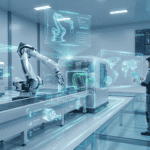Imagine a world where farmers have superpowers. They can see through the soil, control the weather, and talk to their crops. Well, maybe not literally, but with Agriculture 4.0, they’re getting pretty darn close. Imagine a world where farmers have a high-tech toolkit that helps them maximize their yields and minimize their costs. That’s exactly what precision farming, powered by CMMS and IoT, is all about. Farmers can make informed decisions about everything from irrigation to fertilization by collecting and analyzing data from sensors and other devices. It’s like having a crystal ball that shows them exactly what their crops need to thrive.
However, the adoption of Agriculture 4.0 is not without its challenges. The integration of multiple technologies and data sources can pose technical difficulties, problem providing obstacles for some farmers, especially those with limited resources or technical expertise. Additionally, concerns around data privacy, security, and the potential environmental impacts of certain precision farming practices need to be addressed.
Buckle up because we’re about to nerd out on the mind-blowing ways in which Agriculture 4.0: Precision Farming with CMMS and IoT is shaking up the world of food production while also acknowledging and addressing the potential problem-providing factors that could hinder its widespread adoption.
Understanding Precision Farming and Agriculture 4.0

Precision farming, also known as smart farming or Agriculture 4.0, is revolutionizing the agriculture industry. It leverages advanced technologies like IoT, data analytics, and automation to optimize agricultural processes. The goal? To enable farmers to make data-driven decisions that improve crop yields, resource efficiency, and profitability.
Definition of Precision Farming
At its core, precision farming refers to the use of digital tools and technologies to manage crops and livestock more effectively. It involves collecting and analyzing real-time data about soil conditions, weather patterns, and plant health to inform farming decisions. By using precision agriculture techniques, farmers can apply inputs like water, fertilizer, and pesticides more accurately and efficiently. This not only saves resources but also reduces the environmental impact of farming.
Key Components of Agriculture 4.0
Agriculture 4.0 encompasses a wide range of technologies that enable precision farming. Some of the key components include:
- IoT sensors for real-time data collection.
- Drones and satellite imagery for field mapping and monitoring.
- Machine learning algorithms for data analysis and prediction.
- Robotics and automation for tasks like planting, spraying, and harvesting.
These technologies work together to create a smart, connected farming ecosystem that can adapt to changing conditions and optimize production.
Benefits of Precision Farming
The benefits of precision farming are significant and far-reaching. By adopting these technologies, farmers can:
- Increase crop yields and quality.
- Reduce water and chemical use.
- Lower labor costs through automation.
- Minimize environmental impact.
- Improve animal health and welfare in livestock farming.
Ultimately, precision farming techniques help farmers produce more with less while also promoting sustainability and profitability in the long run. As the world population grows and climate change puts pressure on agricultural systems, these benefits will only become more critical.
Role of CMMS in Precision Farming

Effective precision farming relies on advanced technologies and efficient management systems. That’s where Computerized Maintenance Management Systems (CMMS) come in. A CMMS is a software platform that helps farmers plan, track, and optimize maintenance activities for their equipment and assets. In the context of precision agriculture, a CMMS is essential for keeping IoT devices, sensors, and farming machinery in top condition.
What is CMMS?
At a basic level, a CMMS is a centralized database that stores information about a farm’s maintenance operations. This includes data on:
- Equipment inventory and specifications.
- Maintenance schedules and tasks.
- Work orders and repair history.
- Spare parts inventory and procurement.
By digitalizing this information, a CMMS makes it easier for farmers to track and manage their assets. They can access the system from anywhere, automate work orders, and make data-driven decisions about maintenance priorities.
Advantages of Using CMMS in Precision Farming
Implementing a CMMS in precision farming operations offers several key advantages:
- Increased equipment uptime and reliability.
- Longer asset lifespans through proactive maintenance.
- Lower maintenance costs and fewer unexpected breakdowns.
- Improved safety and compliance.
- Better inventory management and parts forecasting.
A CMMS helps farmers maximize the benefits of their technology investments by keeping precision farming equipment running smoothly. It ensures that IoT sensors are always online, drones are ready to fly, and automated systems are functioning properly.
Integrating CMMS with Precision Farming Technologies
To unlock the full potential of precision farming, it’s important to integrate CMMS with other agricultural technologies. This creates a seamless ecosystem where data flows automatically between systems. For example, IoT sensors can feed real-time equipment performance data into the CMMS, triggering predictive maintenance alerts. Drones can capture aerial imagery of fields, which can be analyzed using AI algorithms to detect equipment issues. By integrating these technologies, farmers gain a holistic view of their operations. They can make proactive maintenance decisions based on real-world conditions rather than relying on manual inspections or guesswork.
IoT Applications in Precision Farming

The Internet of Things (IoT) is perhaps the most important technology enabling precision agriculture. By connecting sensors, devices, and machinery to the internet, IoT allows farmers to monitor and manage their operations in real-time. IoT applications in precision farming cover a wide range of use cases, from crop and livestock monitoring to environmental control and asset tracking. Let’s explore some of the most impactful IoT solutions.
IoT Sensors for Data Collection
At the heart of any IoT precision farming system are sensors. These small, low-power devices can be deployed across fields, greenhouses, and livestock facilities to collect real-time data on key parameters like:
- Soil moisture, temperature, and nutrient levels.
- Weather conditions like rainfall, humidity, and wind speed.
- Crop growth, health, and yield.
- Livestock health, activity, and location.
By continuously monitoring these variables, IoT sensors provide farmers with a wealth of data to inform their decisions. They can detect issues early, optimize resource use, and adapt to changing conditions on the fly.
Connectivity Solutions for Precision Farming
Of course, collecting data is only half the battle. To be useful, that data needs to be transmitted from the field to the cloud for analysis and action. That’s where connectivity solutions come in. In precision farming, there are several options for connecting IoT devices:
- Cellular networks (4G/5G) for long-range, high-bandwidth communication.
- Low-power wide-area networks (LPWAN) like LoRaWAN and NB-IoT for battery-operated sensors.
- Satellite communication for remote, off-grid locations.
- Wi-Fi and Bluetooth for short-range, high-density applications.
The choice of connectivity depends on factors like data volume, transmission frequency, power requirements, and cost. By working with a knowledgeable IoT partner, farmers can design a network architecture that meets their specific needs.
Real-Time Monitoring with IoT Devices
With sensors and connectivity in place, farmers can monitor their crops and livestock in real-time using IoT devices. This includes:
- Smartphones and tablets with mobile apps for field scouting and data visualization.
- Smart irrigation systems that adjust water usage based on soil moisture levels.
- Wearable devices for livestock that track location, health, and activity.
- Drones and robots for automated crop monitoring and treatment.
By leveraging these IoT devices, farmers gain a real-time view of their operations. They can make faster, more informed decisions and respond quickly to changing conditions. This level of visibility and control is essential for optimizing yields, reducing costs, and minimizing risk in precision agriculture.
Data Management and Analysis in Precision Farming
Data is the lifeblood of precision agriculture. By collecting and analyzing vast amounts of data from IoT sensors and other sources, farmers can gain deep insights into their crops, livestock, and operations. However, managing and making sense of all that data can be a challenge. That’s where advanced data management and analysis techniques come into play.
Data Collection Methods
The first step in precision farming data management is collection. There are several methods for gathering data from the field:
- IoT sensors that continuously stream data to the cloud.
- Drones and satellites that capture aerial imagery and remote sensing data.
- Farm equipment with embedded sensors that collect data during operation.
- Manual data entry by farmers using mobile apps or web portals.
The key is to collect data from multiple sources and at various scales, from individual plants to entire fields. This provides a comprehensive view of the farming environment and enables more accurate analysis.
Data Analysis Techniques
Once data is collected, it needs to be processed, cleaned, and analyzed to extract valuable insights. This is where advanced data analysis techniques come into play, such as:
- Statistical analysis to identify trends and patterns in crop growth, yield, and quality.
- Machine learning algorithms to predict crop performance and detect anomalies.
- Data visualization tools to create interactive maps, dashboards, and reports.
- Big data platforms to store, process, and analyze large volumes of sensor data.
By applying these techniques, farmers can turn raw data into actionable intelligence. They can identify areas of the field that need attention, optimize resource allocation, and make data-driven decisions about planting, fertilizing, and harvesting.
Machine Learning and AI in Precision Farming
One of the most exciting applications of data analysis in precision farming is machine learning and artificial intelligence (AI). These technologies allow farmers to automate complex decision-making processes and gain predictive insights into their operations. For example, machine learning algorithms can be trained on historical data to predict crop yields, detect diseases, and recommend optimal planting times. AI-powered robots can autonomously navigate fields, identify weeds, and precisely apply herbicides. By leveraging machine learning and AI, farmers can make their operations more efficient, productive, and sustainable. They can reduce labor costs, minimize chemical usage, and adapt to changing weather patterns and market demands.
Precision Farming Techniques for Crop Management
At its core, precision farming is about optimizing crop production through targeted, data-driven management practices. By combining IoT sensors, data analytics, and automation, farmers can tailor their growing practices to the specific needs of each plant and field. Let’s explore some of the most effective precision farming techniques for crop management.
Soil Monitoring and Management
Soil health is the foundation of any successful crop. Precision farming techniques allow farmers to monitor soil conditions in real-time and make targeted adjustments to optimize growth. Using IoT sensors, farmers can track key soil parameters like:
- Moisture levels.
- Nutrient content (nitrogen, phosphorus, potassium).
- pH levels.
- Temperature.
- Electrical conductivity.
By analyzing this data, farmers can create precise maps of soil variability across their fields. They can then apply inputs like water, fertilizer, and lime at variable rates to meet the specific needs of each zone. This targeted approach not only improves crop yield and quality but also reduces waste and environmental impact. Farmers can avoid over- or under-applying inputs, which can lead to runoff, leaching, and soil degradation.
Crop Health Monitoring
In addition to soil monitoring, precision farming also enables real-time crop health monitoring. Using IoT sensors and imaging technologies, farmers can detect signs of stress, disease, or nutrient deficiency in their crops at an early stage. Some common crop monitoring techniques include:
- Spectral imaging to measure plant chlorophyll levels and detect disease.
- Thermal imaging to identify water stress and irrigation needs.
- Multispectral imaging to assess plant health and vigor.
- Sap flow sensors to monitor plant water uptake and transpiration.
By detecting issues early, farmers can take corrective actions before yield is impacted. They can apply targeted treatments like pesticides or fertilizers, adjust irrigation schedules, or even replant affected areas. Crop health monitoring also enables farmers to track growth and development over time. They can use this data to optimize planting and harvesting schedules, predict yields, and plan for future seasons.
Variable Rate Application
One of the most powerful precision farming techniques is variable rate application (VRA). This involves applying inputs like seeds, fertilizers, and pesticides at varying rates across a field based on soil and crop conditions. VRA is typically accomplished using GPS-guided machinery that can adjust application rates on the fly. The machinery is connected to a central control system that uses data from soil and crop sensors to create prescription maps for each input. For example, a VRA system might apply more fertilizer to areas of the field with low nutrient levels while reducing application in areas with sufficient nutrients. This optimizes plant growth while minimizing waste and runoff. VRA can also be used for planting by varying seed density and depth based on soil type and moisture levels. This can improve germination rates and crop uniformity, leading to higher yields and quality.
Precision Livestock Farming
Precision farming techniques are not limited to crops; they can also be applied to livestock management. Precision livestock farming (PLF) uses IoT sensors, data analytics, and automation to optimize animal health, welfare, and productivity. PLF is particularly valuable for large-scale livestock operations, where manual monitoring and intervention are impractical. By leveraging technology, farmers can improve efficiency, reduce costs, and ensure the well-being of their animals.
Animal Health Monitoring
One of the key applications of PLF is animal health monitoring. Using wearable sensors and imaging technologies, farmers can track key health indicators for individual animals, such as:
- Body temperature
- Heart rate
- Respiration rate
- Activity levels
- Feeding and drinking behavior
By analyzing this data, farmers can detect signs of illness or distress early and take prompt action. They can administer targeted treatments, isolate sick animals, and prevent the spread of disease. PLF also enables farmers to monitor animal behavior and social interactions. For example, sensors can detect changes in activity levels or social hierarchy that may indicate stress or aggression. Farmers can then adjust housing or feeding practices to promote animal welfare.
Feed Management
Another important aspect of PLF is feed management. Using precision feeding systems, farmers can optimize the amount and composition of feed for each animal based on its individual needs. For example, sensors can track an animal’s weight, growth rate, and milk production and adjust feed rations accordingly. This not only improves animal performance but also reduces feed waste and costs. Precision feeding can also help farmers reduce the environmental impact of livestock production. By minimizing overfeeding and nutrient excretion, farmers can reduce greenhouse gas emissions and water pollution associated with animal agriculture.
Environmental Control
Finally, PLF enables farmers to control the environment in which their animals live precisely. Using IoT sensors and automation, farmers can monitor and adjust key environmental parameters, such as:
- Temperature
- Humidity
- Air quality
- Lighting
- Ventilation
By maintaining optimal environmental conditions, farmers can reduce animal stress, improve health and welfare, and increase productivity. Sensors can detect when temperatures are too high and automatically adjust ventilation or cooling systems to keep animals comfortable. Environmental control is particularly important in intensive livestock operations, such as poultry or swine farms, where animals are housed in close quarters. By carefully managing the environment, farmers can prevent the spread of disease, reduce odors, and improve air quality for both animals and workers.
Challenges and Future of Precision Farming

While precision farming offers many benefits, it also presents some challenges. Adopting new technologies can be costly and complex, particularly for small-scale farmers. There are also concerns about data privacy and security, as well as the environmental impacts of some precision farming practices. Looking to the future, however, precision farming is poised to play an increasingly important role in meeting the global demand for food while promoting sustainability and resilience.
Adoption Challenges in Precision Farming
One of the main challenges facing precision farming is adoption. Many farmers, particularly in developing countries, lack the resources or knowledge to implement these technologies effectively. Some common adoption challenges include:
- High upfront costs of equipment and software.
- Lack of technical expertise and training.
- Limited access to reliable internet and.
Key Takeaway:
Agriculture 4.0 leverages IoT, data analytics, and CMMS through a middleware cloud approach to make farming smarter. This approach enables real-time crop monitoring, efficient resource use, boosted yields, and cost reduction. Ultimately, the middleware cloud approach increases production while promoting sustainability.
At its core, the middleware cloud approach provides a centralized platform for integrating agricultural technologies. IoT sensor data, analytics, and CMMS are seamlessly connected, empowering farmers with insights to optimize operations. By adopting this approach, farmers can maximize yields, reduce waste, and minimize environmental impact, contributing to a more sustainable and resilient food system.
Future of Farming: Embracing Agriculture 4.0 with CMMS & IoTConclusion
Agriculture 4.0 is here, and it’s not just a buzzword. It’s a game-changer for farmers, consumers, and the planet. At the heart of this revolution lies IoT technology, enabling seamless connectivity and data exchange across precision farming facilities.
Farmers, get ready to level up your game with precision farming, computerized maintenance management systems (CMMS), and IoT connectivity! These high-tech tools are like having a team of farming superheroes on your side, helping you maximize yields and minimize waste. Say goodbye to guesswork and hello to data-driven decisions that’ll make your farm more efficient and sustainable than ever before.
With IoT-enabled sensors and devices, you can monitor soil conditions, track equipment performance, and even automate irrigation systems, all from your farm management system. CMMS, on the other hand, streamlines your maintenance processes, ensuring that your farm machinery is always in top condition, reducing downtime and maximizing productivity.
Embracing Agriculture 4.0 is more than just a savvy business move; it’s a commitment to responsible land management. By leveraging cutting-edge data analysis and technological innovations, farmers can optimize their practices, minimize waste, and ensure the long-term health of our agricultural ecosystem.
Don’t worry if you ever run into any problems or need support; our dedicated support center and thriving social media platform are here to provide solutions and connect you with a community of like-minded innovators in the agriculture industry.
So whether you’re a farmer, a foodie, or just someone who cares about the future of our planet, Agriculture 4.0 is something to get excited about. It’s a new era of farming that’s smarter, more efficient, and more connected than ever before.
Topic: Agriculture 4.0: Precision Farming with CMMS and IoT







